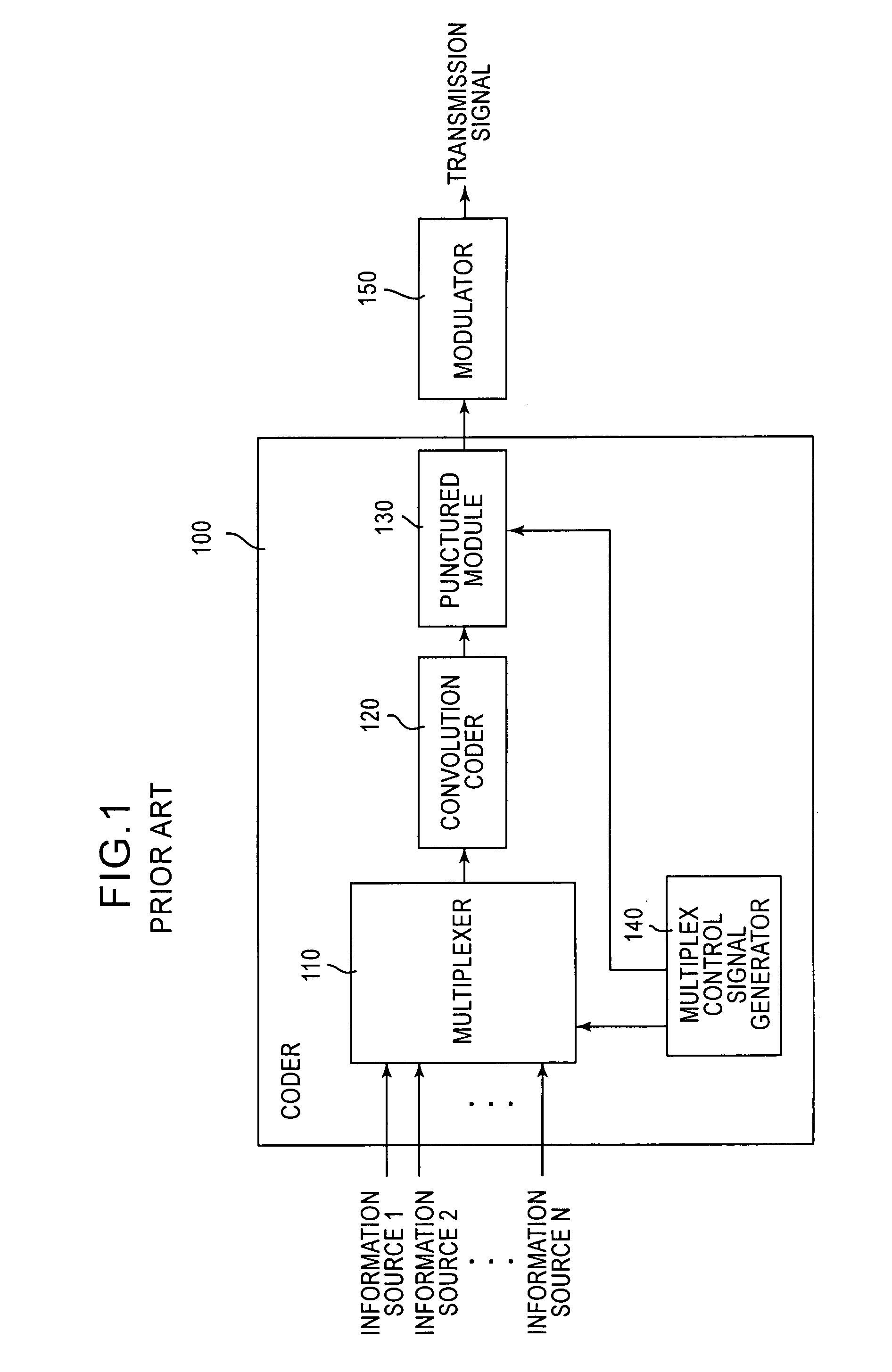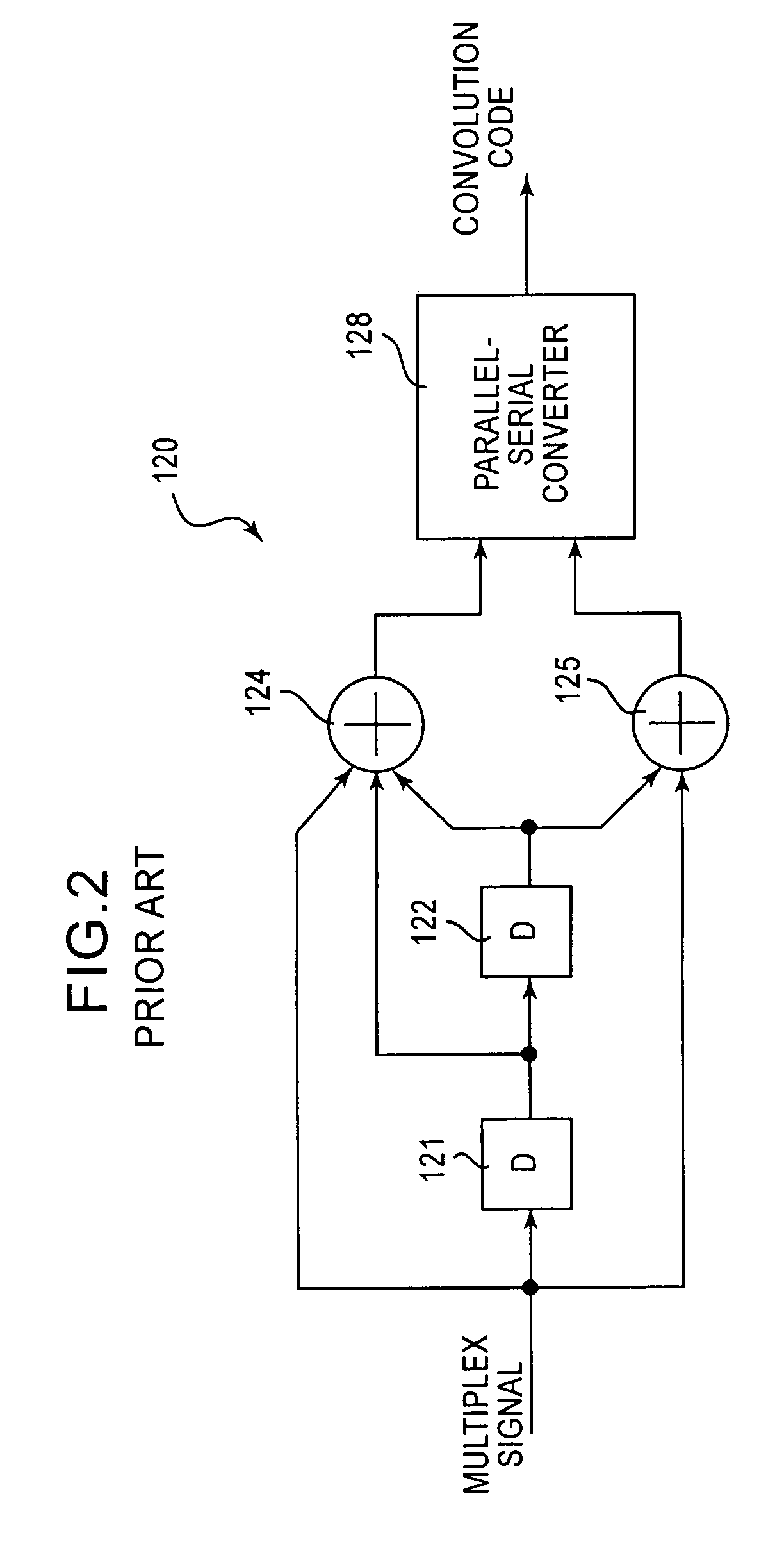Method and apparatus for decoding received data in a communications system
a communication system and received data technology, applied in the direction of coding, code conversion, electrical apparatus, etc., can solve the problems of reducing transmission efficiency, increasing the number of structure bits, and worse reception, and achieve high stability and reliability
- Summary
- Abstract
- Description
- Claims
- Application Information
AI Technical Summary
Benefits of technology
Problems solved by technology
Method used
Image
Examples
first embodiment
[0069]FIG. 7 is a block diagram showing a schematic structure of the decoder according to the The decoder 10 shown in FIG. 7 is provided with a signal-to-noise ratio monitor 12 and a comparator 14. The signal-to-noise ratio monitor 12 measures strength of noise from a signal input into the depuncture module 210 so as to digitize the measured noise strength. The comparator 14 compares the output of the signal-to-noise ratio monitor 12 with a predetermined value and outputs a signal representing the result of comparison (hereinafter, referred to as a post signal). The multiplex control signal generator 250 outputs an initialization signal to the Viterbi decoder 220 based on the post signal received from the comparator 14. This process is different from the one executed in the conventional decoder 200.
[0070]The legends same as in FIG. 5 are provided to the other components which are common to those of the conventional decoder 200, and the explanation thereof is omitted. The Viterbi de...
second embodiment
[0088]The decoding method and the decoder initialize the Viterbi decoder 220 in the transmission system which transmits and receives data composed of multiplexed data stream at the point that the strength of noise mixed in the received signal exceeds the predetermined value and the data stream having coding rate of low error correction ability is changed into the data stream having coding rate of high error correction ability. As a result, the coded result with high reliability which is not much influenced by the noise can be obtained.
[0089]A decoding method and a decoder according to a third embodiment will be now explained. The decoding method and the decoder according to the third embodiment have the following characteristic in addition to the characteristic of the decoder 30 according to the second embodiment. Precisely, a plurality of multiplexed data stream are extracted from the data stream decoded by the data stream decoder 240 so as to be distributed.
[0090]FIG. 10 is a blo...
third embodiment
[0097]Operations of the decoder 60 which are different from those in the third embodiment will only be explained here. A plurality of information source data are coded by a system composed of the Reed-Solomon coding circuit, the frame structure circuit, the energy dispersion circuit and the interleaver in the multiplexer 110 of the coder 100. Moreover, the multiplex information is coded by the Reed-Solomon coding circuit and the energy dispersion circuit, and a synchronous code is added to the information source data and the multiplex information and they are multiplex. As a result, the data stream output from the coder of the transmitter is obtained.
[0098]The synchronizer 62, in the same manner as shown in FIG. 6, generates a control signal to be input into the multiplex control signal generator 250. Moreover, the synchronizer 62 extracts the data stream and the data stream representing the multiplex information from the input signal.
[0099]The data stream extracted in the synchroni...
PUM
 Login to View More
Login to View More Abstract
Description
Claims
Application Information
 Login to View More
Login to View More - R&D
- Intellectual Property
- Life Sciences
- Materials
- Tech Scout
- Unparalleled Data Quality
- Higher Quality Content
- 60% Fewer Hallucinations
Browse by: Latest US Patents, China's latest patents, Technical Efficacy Thesaurus, Application Domain, Technology Topic, Popular Technical Reports.
© 2025 PatSnap. All rights reserved.Legal|Privacy policy|Modern Slavery Act Transparency Statement|Sitemap|About US| Contact US: help@patsnap.com



